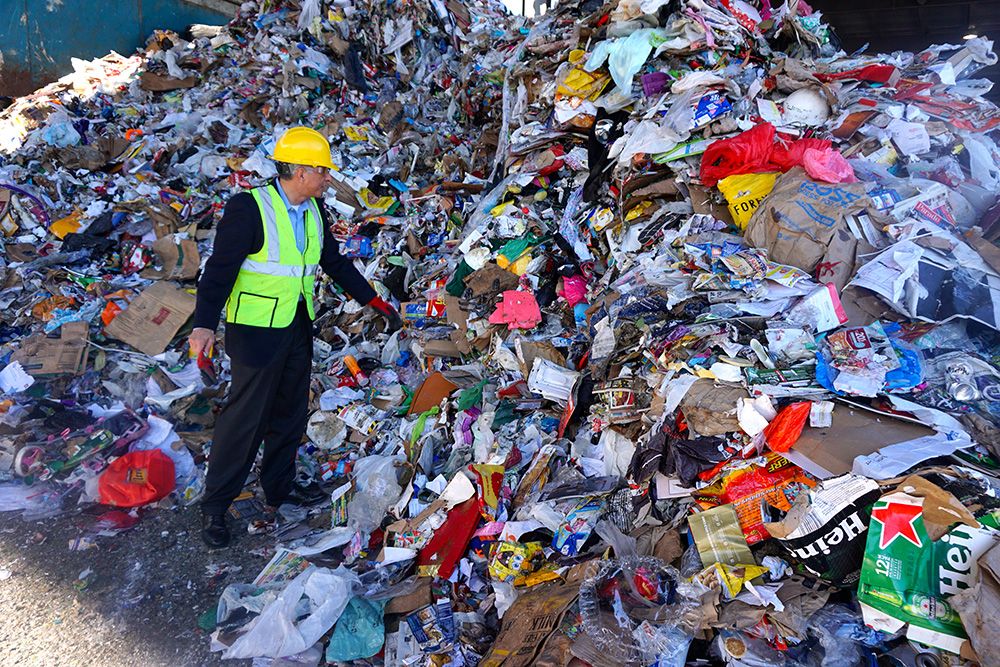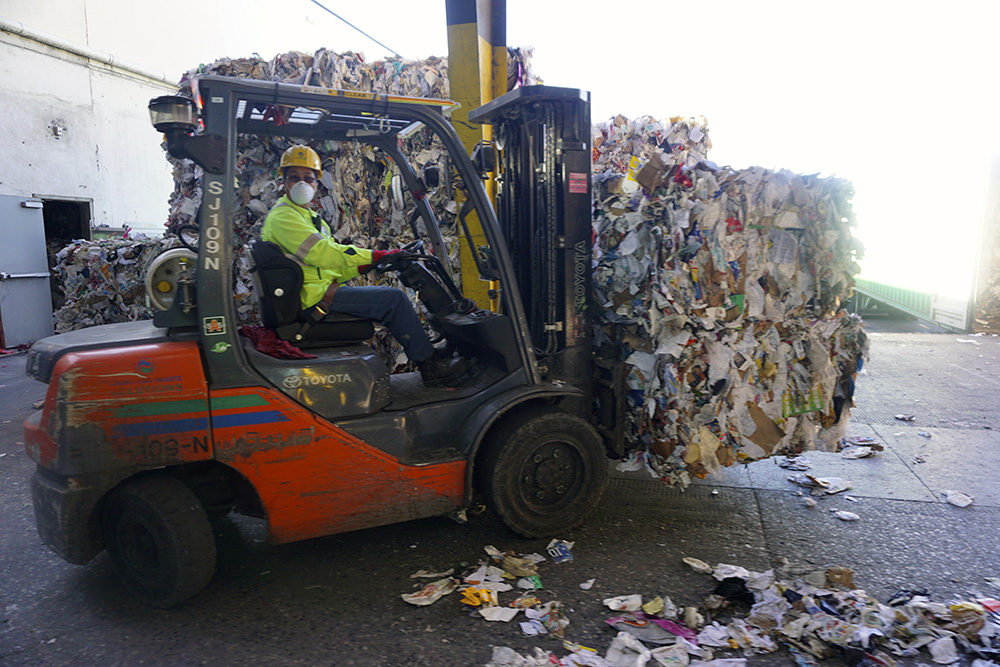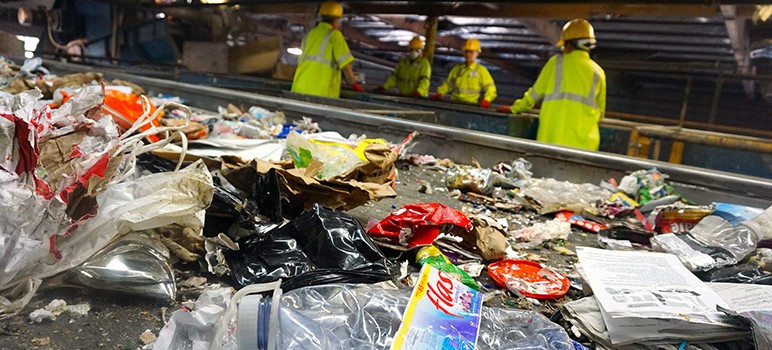With gloved hands, Joel Corona rifles through the refuse scattered about a stalled conveyor belt. Used diapers. A full can of beans. Batteries. Wadded-up toilet paper. Food-caked takeout containers. Greasy pizza boxes.
“It’s trash,” says Corona, the chief operating officer of California Waste Solutions (CWS), which picks up about 75 percent of the San Jose’s curbside recycling. “We aren’t equipped to deal with this much of it.”
Some of the worst things people have chucked in recycling bins, he says, include dead animals, hypodermic needles—some of which have punctured workers, forcing them to undergo blood tests—batteries and toxic chemicals. In summer 2014, sorters found an explosive device meandering down a conveyor belt, prompting a visit from the San Jose Department's bomb squad.
Earlier this week, a propane canister blew up when it got caught in a piece of equipment. Thankfully, Corona says, no one got hurt.
“It was a very loud explosion, with fire and lots of smoke,” he says. “But this happens routinely. Propane tanks are a prohibited material, but we get them all the time.”
At the CWS plant in north San Jose, optical sorters, crushers and massive conveyer belts divert thousands of pounds of plastic, paper and other recyclables from the landfill each day. But roughly 40 percent of the haul from single-family homes is non-recyclable garbage—six times the rate in Oakland.
The extent of the problem came to light in an audit last fall, which ignited tensions between the city and its largest recycling collector. CWS has racked up hundreds of thousands of dollars in fines for falling short of its goals.
A city-hired consultant says that’s because the company lacks workers and relies on outdated equipment. CWS maintains that it’s the fault of residents for tossing too much trash in their recycling carts, and the city for failing to penalize them.
Despite the city’s goal to reach “zero waste” by 2022, auditors found that landfill diversion rates—the amount of recycling collected in those big blue bins—have fallen citywide. Recycling rates for single-family homes fell from 36 percent in 2008 to 27 percent in 2014. But auditorys say diversion rates are much worse in districts covered by CWS.
Corona blames the city. He says San Jose’s Environmental Services Department, which oversees the contracts for CWS and its secondary hauler GreenTeam, never fines people who dump trash in the blue bins. The city should also stop forcing the company to pick up contaminated carts, he says, and reduce the cost of upsizing the garbage bins so people won’t toss overflow in with recycling.
Last fall, the City Council agreed to study rate increases for customers and fines for repeat violators. The council also ordered an analysis to see whether contamination has worsened over the years, as CWS claims. In January, results of that curbside audit came back to the council showing that, in the two districts covered by CWS, contamination rates are about a third higher than the area serviced by GreenTeam.
Part of the problem may stem from broader trends, including technical challenges in responding to changing consumer behavior and the free-falling price of recyclables in the global market. Yet locally, the city says, the contents of the waste remain relatively unchanged, except that the amount of overall recyclable materials has fallen.
“Households are taking our messages of reduce and reuse to heart and setting out less material,” says Jo Zientek, deputy director of San Jose’s Environmental Services Department.
For example, considerably fewer newspapers come in since the print industry’s post-recession decline. And with more people going paperless, there’s less junk mail. Packaging has also become more lightweight. Coffee cans have been replaced by vacuum-sealed bags. Tuna cans, too. The amount of plastic that once went into 22 water bottles now makes 36. Changing material ratios have upped the cost for recyclers and the public agencies that hire with them.

California Waste Solutions COO Joel Corona shows how the 40 percent contamination rate makes the recycling plant look more like a landfill.
“The makeup of the material has not changed,” says Kerrie Romanow, head of the city’s Environmental Services Department. “[CWS] will continue to assert that it has, but the report of the facility says there are other reasons: maintenance and staffing.”
Contamination rates nationwide have risen since companies in the early 2000s switched to single-stream recycling—that is, having consumers put reusable items in one big bin instead of sorting them in separate carts before pickup. While the simplified process upped recycling participation by 30 percent, the quality of the recyclables took a hit, according to the Solid and Hazardous Waste Education Center.
CWS has proposed upgrading the facility to deal with that influx of trash, but Romanow worries that the company would push that cost on to residents. “Certainly our expectation would be that we would not invest in a facility that isn’t performing,” she says.
Meanwhile, councilmembers Johnny Khamis, Ash Kalra and Magdalena Carrasco want the city to suspend fines against the company. Complicating the issue: CWS’ political clout and ties to a decade-old scandal that led to then-Mayor Ron Gonzales’ indictment on corruption charges (which were later thrown out).
Company founder David Duong—a Vietnamese immigrant who holds big-money contracts in Oakland, Sacramento and Ho Chi Minh City—has positioned himself as one of the biggest campaign contributors in local elections.
Duong defended himself in a letter to the council last fall, noting his “company has already been wrongfully fined nearly $1 million and suffered losses of over $9 million as a result of [the city’s] failure to fix the single-family dwelling recycling program.” He said San Jose’s “inaction is the cause of the problem.”
Others on the council worry that CWS is trying to shirk responsibility, blaming residents for the excess trash while their counterparts deal with it. CWS issues about 3,600 non-collection notices a month; GreenTeam, only 11. Corona says that’s because GreenTeam, which processes recycling for 15 percent of the city, subcontracts with Green Waste Recovery.
Romanow asked CWS to take a page from its competitor by sending its trash to another facility. “The real disappointment, from our perspective, is that we had a recommendation that would have increased the diversion rates,” she says. “We could have done that as soon as the council approved it. But they said no.”
Corona says CWS would rather process the contamination on site. “If the city is disappointed in anything, it should be disappointed that it has an obligation to address repeated violations,” he says.
Romanow, however, says her concern is that CWS will ask the city for money to improve its facility, which risks pushing the cost back to ratepayers. When San Jose renegotiated in 2011 with CWS and GreenTeam to extend their contracts through 2021, she says, only the latter reinvested some of that “windfall” to improve diversion. Corona argues otherwise, noting that he doesn't want customers to eat the cost either.
“Everyone else has done it on their own,” Romanow says. “We don’t know what CWS has planned. That’s what we’re waiting to see.”

A CWS worker moves bales of recyclables, which end up getting shipped to China.


The right solution here would be to turn it into diamonds. Heat, pressure, waste gets turned into precious gemstones as most of it is carbon based.
San Jose resident here– the reason for contamination couldn’t POSSIBLY be that San Jose gives its residents a teeny, tiny black trash can, a great big recycling can, and charges $6 for every extra trash bag? Just hazarding a guess.
Since the City Council embraces “the homeless” by funding so many non-profit services, it attracts urban foragers like mad. These undocumented recyclers go through recycling bins, cherry picking the redemption values and leaving the less valuable stuff for the commercial recyclers.
Part of the solution is to stop wasting taxpayer money on homeless issues and let the non-profits and churches handle it themselves… organically one might say.
Jate Naereg – My solution. I cherry pick all CRV aluminum and plastic plus all glass and redeem them myself. Nothing left for the shoopping cart thieves but cardboar, random paper and non redeemable plastic.
There seems to be lots of profit in recycling. I think the city would benefit greatly if they would catch and fine the little bastard’s that are rummaging through our trash cans starting Thursday morning and continuing past midnight.
I now put the cans out after 2 am. I’ve been threatened by them if I chase them off and I now take a big flashlight if out front on collection night.
Could that be where your profits are going?
Try calling the San Jose Police when the cans are being stripped of *everything* of value [ house after house- can after can ] — 311 will say– we don’t handle that. When it is pointed out that if you stop the small crimes, you prevent the larger ones, shrug. NOT the Police Dept’s fault– it is because the homeless are protected and valued far in excess of homeowners and renters. Or the City coffers.
Every Wednesday morning at 2 or 3 am I hear people with carts going from house to house taking the recyclables before pick up at 8am.
I think the public, some household recyclers are missing the target for simple reasons that adjustable.
Simply…….residents control what goes in the household recyclable containers.
In my household of 2.5 we use the smallest trash bin available and I think we do a effective job collapsing boxes and recycling the items appropriately. Many other households do the same, but then there are households that don’t effectively monitor what’s being put in thehousehold recyclable bin, especicially if the actual trash bin is full from not recycling items properly. There are many reasons why that does happen. Much room can be saved in the trash bin if cans, bottles, paper products, plastics etc. are placed in the recyclable bin.
It’s important to point out that empty plastic containers that once contained liquids like liquid bleach & soaps, liquid plumbing aids, household chemicals etc. should be rinsed clean in a sink at home.
When these containers are placed unrinsed in the recycle bin they may leak. After the items are pick up by the neighborhood collection program they are transported to the processing facility where items are sorted as mentioned in the news article.
The trash being placed in the wrong containers is now arriving at the wrong facility having to be sorted from recyclables. That’s the dangerous, nasty, time consuming and environmentally unfriendly process that is creating parts of these issues.
Back to the plastic containers that previously contained household chemicals and solutions.
When those containers are crushed to bale in preparation for transportation to the appropriate industrial recycler, they leak the residual chemical and solutions that they once contained. If it’s raining this compounds the problem for storage sites, transportation facilities & methods and any contact with rain or runoff could be harmful to the environment.
So the big point is that…… proper recycling starts with the general public and or residents.
Industrial and Commercial Trash and Recycling separation facilities are then responsible for processing what arrives. The problems happening at the separation facility and in transportation are results of improperly prepared and processed residential waste materials by the resident and or each household. Currently some residential processes are creating the time consuming, environmentally unfriendly, and costly unneeded and unnecessary extra separation work.
The only way the city could address neighborhood recycling and trash operations would be to dedicate staff to enforce municipal code, which means “can inspectors, warnings, citations, fines, administrative citations and appeals processes”. All money and time consuming while making the community unhappy.
All this could be minimized, if not prevented when household trash and recyclables are processed properly. How are we gonna make that happen?